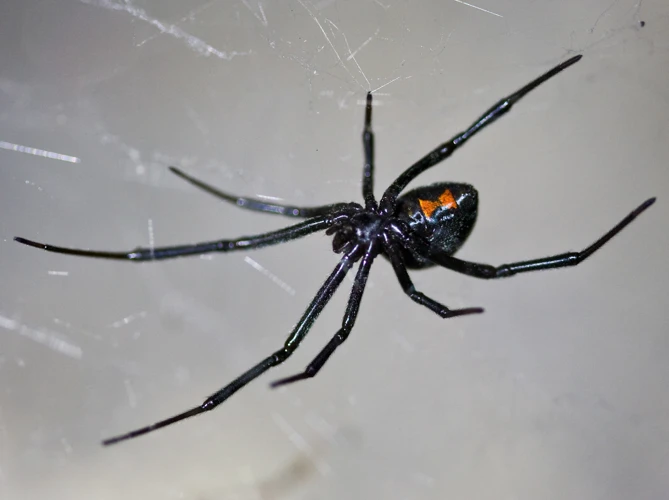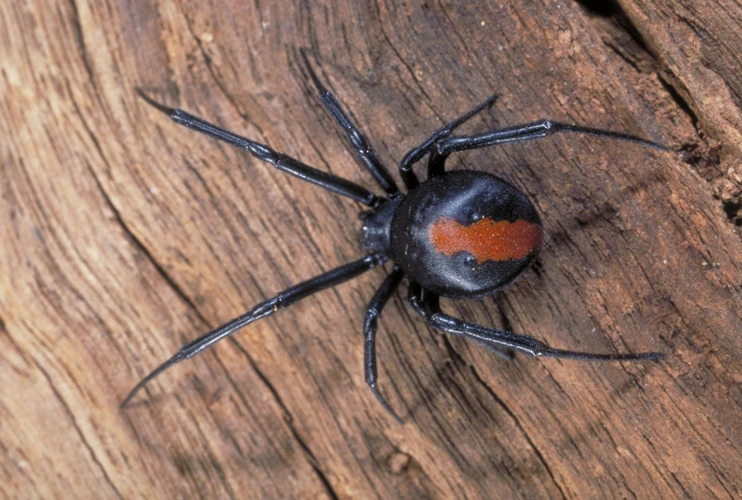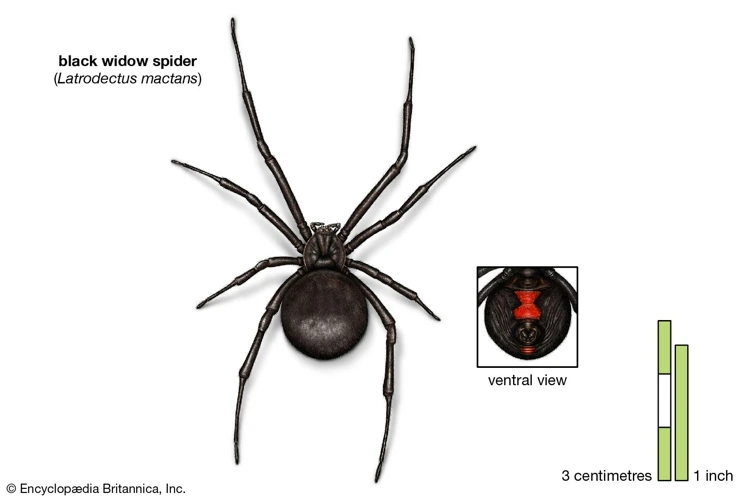Black widow spiders are known for their deadly venom and distinctive appearance. While they may strike fear in the hearts of many, there are actually several different species of black widow spiders, each with their own unique characteristics. From the shape and colors of their bodies to their geographic distribution, there is much to learn and explore when comparing the morphology of different black widow spider species. In this article, we’ll dive into the characteristics of several black widow species, including the Southern Black Widow, Northern Black Widow, Western Black Widow, Eastern Black Widow, Redback Spider, and Brown Widow Spider. Get ready to explore the fascinating world of black widow spiders like never before!
The Genus Latrodectus

The genus Latrodectus is a group of venomous spiders commonly known as the black widow spiders. These spiders are known for their distinctive appearance characterized by a shiny black body and red hourglass mark on the abdomen. The black widow spiders are often found in temperate regions around the world and are known for their potent neurotoxic venom. Despite their notorious reputation, these spiders are considered to be economically important, culturally significant, and play an essential role in their ecosystem. In this article, we will take an in-depth look at the morphology of different black widow spider species belonging to the genus Latrodectus.
Distinctive Characteristics
The Genus Latrodectus is a group of venomous spiders which includes several species such as the Southern black widow, Northern black widow, Western black widow and Eastern black widow. While all these species belong to the same genus, each has some distinctive characteristics that set them apart.
Distinctive Characteristics of Black Widow Spiders:
- Size: Black Widow spiders range in size from 3 to 10 mm in length, with females being larger than males in most species.
- Color: The black widow spider is named after its distinctive black color. However, it is not entirely black. It has a characteristic red hourglass shape on its ventral side, which helps distinguish it from other spider species.
- Web: The black widow spider creates a messy, tangled web that she spins herself. The web is used to trap prey and can be found in cluttered areas such as piles of wood and debris.
- Bite: The bite of a black widow spider can be very painful and potentially deadly, depending on the amount and potency of the venom injected. The venom is a neurotoxin that affects the nervous system and can cause muscle pain, spasms and paralysis.
Each species of black widow spider also has additional features that help distinguish it from others within the same genus.
For example, the Southern Black Widow and Northern Black Widow are very similar in appearance, but their geographic ranges are different. The Southern Black Widow is found in the southeastern United States, while the Northern Black Widow is found in northern and western regions of North America.
Likewise, the Western Black Widow and Eastern Black Widow have some subtle morphological differences that make them distinct. For example, the Western Black Widow has a range of colors that can vary from brownish-black to shiny black with a more pronounced hourglass marking, while the Eastern Black Widow usually has more reddish markings on its back and a less prominent hourglass shape.
All of these distinctive characteristics make it possible for experts to identify different species of black widow spiders, which is important for understanding the diversity and distribution of these venomous arachnids.
To learn more about the black widow spider, you can also read our article on black widow courtship rituals.
Southern Black Widow vs Northern Black Widow
The Southern Black Widow and Northern Black Widow are two of the most well-known black widow species in North America. Both species have distinctive characteristics that set them apart.
The Southern Black Widow:
- The Southern Black Widow is more commonly found in the southern parts of North America.
- Their venom is considered to be more toxic than the venom of the Northern Black Widow.
- They have a distinctive red hourglass-shaped marking on their underside.
- Their color varies from jet black to dark brown.
The Northern Black Widow:
- The Northern Black Widow is more commonly found in the northern parts of North America.
- Their venom is considered to be less toxic than the venom of the Southern Black Widow.
- They have a distinctive red hourglass-shaped marking on their underside like the Southern Black Widow.
- Their color varies from jet black to dark brown.
While there may be some overlap in terms of range for these two species, their respective habitats tend to keep them separated. Southern Black Widows prefer warmer temperatures found in the south, while Northern Black Widows can be found in the cooler climatic regions to the north. The two species can also be distinguished by their venom strength and the color of their abdomen.
If you want to learn more about black widows, check out our article on analyzing the venom of black widow spiders.
Western Black Widow vs Eastern Black Widow
The Western Black Widow and Eastern Black Widow are two of the most commonly recognized Black Widow spider species in North America. They can be identified by their similar physical characteristics, but there are still some differences that set them apart.
To compare and contrast these two species, we have created a table that highlights some of the key differences between them based on their morphological features:
| Characteristics | Western Black Widow | Eastern Black Widow |
|---|---|---|
| Body Color | Shiny black with a distinctive hourglass-shaped red mark on the abdomen | Shiny black with a distinctive hourglass-shaped red mark on the abdomen |
| Abdomen Shape | Globular or rounded | Flattened and elongated |
| Abdomen Patterns | May have red marks or spots on dorsal or ventral side | May have red spots or stripes on dorsal or ventral side |
| Size | Usually smaller in body size and leg span | Can be larger in body size and leg span |
| Web Structure | May build webs in the vegetation | May build webs in more open areas |
It is important to note that the differences between these species are relatively minor. Both species have venom that is potent enough to cause serious harm to humans, and they can both be found in areas throughout North America.
If you want to read more about the morphological features of Black Widow spider egg sacs, check out our article on morphological features of Black Widow spider egg sacs.
Redback Spider

The Redback Spider is a close relative of the infamous Black Widow spider and is found primarily in Australia. This spider is easily recognized by the distinctive red or orange stripe on the upper side of its abdomen. While it shares some similarities with other species of the widow spider, the Redback Spider also has several unique physical differences that set it apart. Let’s take a closer look at these distinctive features and see how they compare to other widow spiders.
Physical Differences from Other Black Widow Spiders
When compared to other Black Widow spider species, there are a few physical differences that distinguish the Redback spider. For instance, the Redback spider has a more prominent red or orange stripe on its back that is easily identifiable. In contrast, most Black Widows feature a red or orange hourglass shape on their bellies. Additionally, the Redback spider tends to be smaller and rounder than its Black Widow counterparts. This makes it easier to distinguish them from other types of Widow spiders.
Unlike other Black Widow spiders, the Redback spider has been known to have a more diverse color palette among individuals of the same species. Some individuals may have a red stripe that is more orange, while others may have it as a bright apple red. This variety in coloration makes it easier to differentiate between different members of the same species.
In terms of venom toxicity, the Redback spider’s venom is considered just as lethal as that of other Black Widow spiders. However, the amount of venom delivered in a bite may be slightly less due to the smaller size of the spider. Despite its smaller size, the Redback spider is still considered a potent venomous species and should be treated with caution.
In conclusion, the Redback spider has a few distinguishing features compared to other Black Widow spiders. Its prominent red or orange stripe on its back, its smaller and rounder body shape, and the variety in its color palette are some of the most notable physical differences between the Redback and other Black Widows.
Brown Widow Spider
The Brown Widow Spider is another species belonging to the Latrodectus genus. It is often confused with the black widow spider due to their similar shape and coloration, but there are some physical differences that set them apart. Let’s take a closer look at the unique characteristics that make the Brown Widow Spider stand out from the other widow spiders.
Physical Differences from other Widow Spiders
The Brown Widow Spider has some physical differences from other Widow Spiders, including the Black Widow. Unlike the Black Widow spider, the Brown Widow spider has a dorsal stripe that is usually orange or yellow in color. Additionally, the hourglass design on the Brown Widow spider is not typically a bright red but is instead an orange or yellowish-orange color.
Brown Widow spiders are typically smaller than Black Widow spiders. They also have smooth egg sacs in comparison to the spiky egg sacs of Black Widows. In terms of web-building, Brown Widows tend to build their webs closer to the ground and in more cluttered areas, whereas Black Widows prefer hidden, higher locations.
Here is a table comparing the physical differences between Brown Widows and Black Widows:
| Brown Widow Spider | Black Widow Spider | |
|---|---|---|
| Color of Dorsal Stripe | Orange or Yellow | Black |
| Color of Hourglass Design | Orange or Yellowish-Orange | Bright Red |
| Size | Smaller | Larger |
| Egg Sacs | Smooth | Spiky |
| Web-building Location | Closer to ground and cluttered areas | Hidden, higher locations |
It’s fascinating to observe the differences between these two spiders and how they have evolved to adapt to their specific environments. To learn more about Black Widow spiders, check out this article on the economic importance of Black Widow spiders.
Male vs Female Brown Widow Spiders
The Brown Widow spider (Latrodectus geometricus) is a unique member of the Latrodectus genus, exhibiting many distinctive qualities, such as different ecological needs, and specific locations, where they prefer to reside. One of the most striking differences between male and female Brown Widow spiders is their size. Females are significantly larger than males in both body size and leg span.
Male and female Brown Widow spiders exhibit notable differences in coloration. While females typically have a characteristic dark brown color with white, beige, or orange stripes on their abdomen and legs, males are typically lighter in color, displaying an orange body color with the same white, beige, or orange stripes.
Another difference worth noting is that male Brown Widows also have a more glossy appearance of their exoskeleton, contrasting with the more matte appearance found in females. Males have a totally different body shape, featuring elongated body parts, in contrast to the rounder bodies of females.
To see these differences at a glance, refer to the following table:
| Female Brown Widow Spiders | Male Brown Widow Spiders | |
|---|---|---|
| Size | Larger body size and leg span | Smaller body size and leg span |
| Coloration | Dark brown with white, beige, or orange stripes | Lighter orange body color with the same stripes |
| Exoskeleton Appearance | Matte appearance | Glossy appearance |
| Body shape | Rounder body shape | Elonagted body shape |
The differences between male and female Brown Widow Spiders are more subtle than in other species of Black Widows but still present, especially in size and coloration. These characteristics are important for researchers studying the behavior and evolutionary biology of this spider species.
Conclusion
In conclusion, the morphology of black widow spiders varies significantly between different species. While all black widow spiders share certain physical characteristics, such as the distinctive red hourglass on their abdomen and their venomous bite, there are also clear differences that set them apart. The two main groups of black widow spiders, Southern and Northern, as well as Western and Eastern black widows, have distinct physical variations that reflect their habitats and evolutionary paths.
Redback spiders, a close relative of the black widow, have a similar appearance, but there are also physical differences that allow for easy differentiation. Similarly, the Brown Widow spider shares certain characteristics with black widow spiders, but also has distinguishing features such as the geometric patterns on their egg sacs.
These differences in morphology and appearance are important to understand for those studying these spiders’ behavior, habitat, and evolutionary history. They also demonstrate the variety of life and diversity that exists within the animal kingdom.
Further research on black widow spiders could explore their cultural significance, life cycle, genetic diversity, and threats to their survival. Understanding the taxonomy and classification of these spiders can also inform conservation efforts to protect these important species. Despite some fearsome myths associated with them, black widow spiders play an important role in the ecosystem and are a valuable subject for ongoing research.
Frequently Asked Questions
What is the Latin name for the black widow spider?
The Latin name for the black widow spider is Latrodectus.
What are the distinctive characteristics of the black widow spider?
The body of the black widow spider is black and shiny, and they have an hourglass-shaped red or yellow mark on their abdomen.
What is the difference between the Southern and Northern black widow spiders?
The Southern black widow spider is larger and has a more rounded abdomen than the Northern black widow spider. The Southern black widow spider also has a more consistent red marking on its abdomen, while the Northern black widow spider may have a broken or incomplete marking.
What is the difference between the Western and Eastern black widow spiders?
The Western black widow spider has a more round and bulbous abdomen than the Eastern black widow spider, which has a more elongated and slender abdomen. The markings on the Eastern black widow spider are usually more red than on the Western black widow spider.
What is the redback spider?
The redback spider is a species of venomous spider closely related to the black widow spider. It is found in Australia and is easily recognized by the red stripe on its abdomen.
What are the physical differences between the redback spider and other black widow spiders?
The redback spider is smaller than other black widow spiders, with a shorter and rounder body. It also has a more prominent and distinct red marking on its abdomen.
What is the brown widow spider?
The brown widow spider is a species of venomous spider that is similar in appearance to the black and redback widow spiders but has distinct physical differences.
What are the physical differences between the brown widow spider and other widow spiders?
The brown widow spider has a tan or brown color on its body, which tends to be more bulbous and less shiny than the black widow spider. It also has a distinctive hourglass-shaped marking that is orange or yellow in color.
What is the difference between male and female brown widow spiders?
The male brown widow spider is smaller than the female and has a more varied coloration that includes black, white, brown, and yellow. The male brown widow spider also has longer legs than the female and does not have a visible hourglass marking on its abdomen.
Are black widow spiders dangerous?
Yes, black widow spiders are venomous and their bites can cause serious health problems, especially in young children, the elderly, and those with weakened immune systems.






